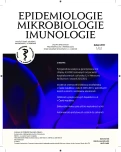Phylogenetic Analysis and Genotyping of A/H3N2 Influenza Viruses Isolated from Patients Hospitalised with Influenza-Like Illness Symptoms in the Na Bulovce Hospital in the Season 2011/2012
Authors:
Nagy Alexander 1; Jiřincová Helena 1; Havlíčková Martina 1; Džupová Olga 2,4; Herrmannová Kristýna 3,4; Trojánek Milan 3,4; Marešová Vilma 3,4; Nováková Ludmila 1; Kynčl Jan 1
Authors‘ workplace:
Státní zdravotní ústav, Centrum epidemiologie a mikrobiologie, Praha
1; 3. lékařská fakulta, Univerzita Karlova v Praze
2; 2. lékařská fakulta, Univerzita Karlova v Praze
3; Klinika infekčních nemocí, Nemocnice Na Bulovce, Praha
4
Published in:
Epidemiol. Mikrobiol. Imunol. 62, 2013, č. 1, s. 4-8
Overview
Influenza A virus is an important cause of acute respiratory infections (ARI). Clinical manifestations of ARI vary from mild or moderate to life-threatening conditions requiring intensive care. Given the segmented genome, a large natural reservoir of other influenza virus subtypes, and antibody selection pressure in the population, the virus is variable and genetically unstable. The phylogenetic analysis and genotyping of A/H3N2 influenza viruses isolated from patients hospitalised with influenza-like illness symptoms in the Na Bulovce Hospital in the season 2011/2012 support the assumption that the pathogenicity is a polygenic trait modifiable by the host health status and seems not to be unambiguously associated with any specific mutations.
Keywords:
influenza A virus, phylogenetic analysis – genotyping – hospitalization – clinical symptoms
Sources
1. European Centre for Disease Prevention and Control Weekly Influenza Surveillance Reports. Dostupné na www:
<http://www.ecdc.europa.eu/en/healthtopics/seasonal_influenza/epidemiological_data/Pages/Weekly_Influenza_Surveillance_Overview.aspx>.
2. Felsenstein, J. PHYLIP (Phylogeny Inference Package) Version 3.6. Distributed by the Author. Department of Genome Sciences, University of Washington, Seattle, 2004. Dostupné na www: <http://evolution.genetics.washington.edu/phylip.html>.
3. Garten, R. J. et al. Antigenic and genetic characteristics of swine-origin 2009 A(H1N1) influenza viruses circulating in humans. Science, 2009, 325, pp. 197–201.
4. GISAID (Global Initiative of Sharing Avian Influenza Data) 2011. Dostupné na www: <http://platform.gisaid.org/dante-cms/struktur.jdante?aid=1131>.
5. Hall, T. A. BioEdit: a user-friendly biological sequence alignmentu editor and analysis program for Windows 95/98/NT. Nucleic Acids Symposium Series, 1999, 41, pp. 95–98. Dostupné na www: <http://www.mbio.ncsu.edu/RNaseP/info/programs/BIOEDIT/bioedit.html>.
a7. Krumbholz, A., Philipps, A., Oehring, A., Schwarzer, K., Eitner, A., Wutzler, P., Zell, R. Current knowledge on PB1-F2 of influenza A viruses. Med. Microbiol. Immunol., 2011, 200, pp. 69–75.
8. Nagy, A. Černíková, L., Křivda, V., Horníčková, J. Digital genotyping of avian influenza viruses of H7 subtype detected in central Europe in 2007–2011. Virus Res., 2012, 165, pp. 126–133.
9. Tamura, K., Dudley, J., Nei, M., Kumar, S. MEGA4: molecular evolutionary genetics analysis (MEGA) software version 4.0. Mol. Biol. Evol., 2007, 24, pp. 1596–1599.
10. World Health Organization Manual for the Laboratory diagnosis and virological surveillance of influenza [on line]. 2011 [cit.2012-12-18]. Dostupné na www:
Labels
Hygiene and epidemiology Medical virology Clinical microbiologyArticle was published in
Epidemiology, Microbiology, Immunology

2013 Issue 1
Most read in this issue
- Bacterial Infection as a Cause of Infertility in Humans
- Antimalarial Prophylaxis in Travelers to Malaria Risk Areas
- Differences in the Incidence of Viral Hepatitis A and E in the Czech Republic
- Incidence of Tick-Borne Encephalitis in the Czech Republic in 2001–2011 in Different Administrative Regions and Municipalities with Extended Power
